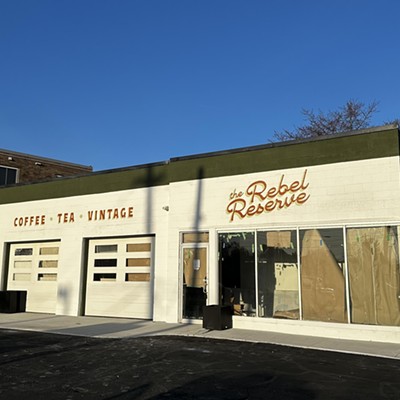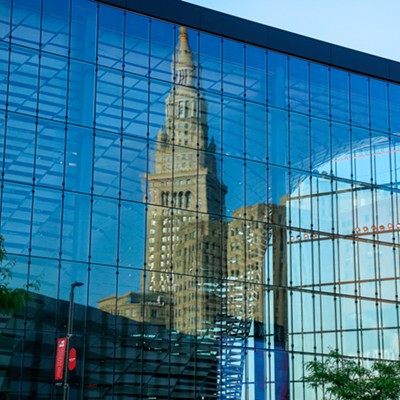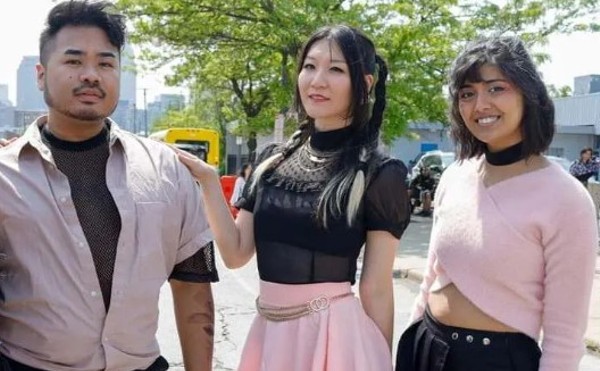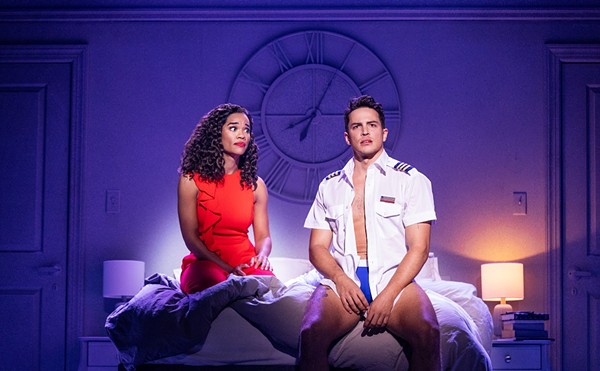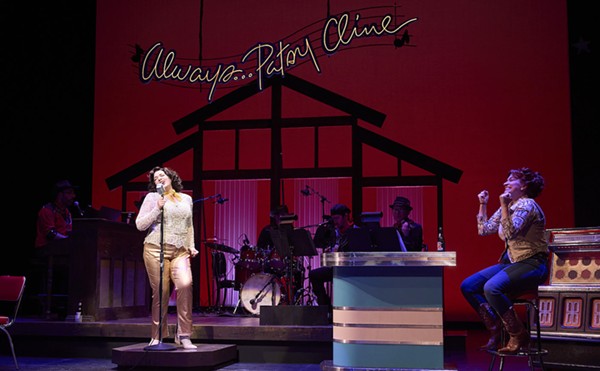Bornwaking -- Amazing that it's possible to bond with a hologram, but Cleveland native Mike Jones proves it with this simple, ritualistic video installation that forges a connection between him and his viewers. A small, square fabric screen stretched taut between ceiling and floor displays a film, projected by a machine suspended at the same height, of Jones' head being baptized with oil. His eyes remain closed while his mouth opens and shuts, as he accepts the inundation patiently and solemnly. The allusion to the biblical practice of anointing with oil is strong, and indeed, the brightly lit film is akin to witnessing a religious assumption. In fact, it's a strangely personal scene, rendered all the more intimate by the extremely close-up view and the way the head floats bodiless in the middle of a completely dark space. Composer Ryan Lott's low, murmuring, repetitive soundtrack, with its hint of a choir in the distance, augments the austere, sanctified mood significantly. But the real coup de grâce is the shelf near the exit, lined with small vials of oil. Taking one is like carrying a piece of the artist home with you. Through September 30 at Spaces, 2220 Superior Viaduct, 216-621-2314, www.spacesgallery.org. -- Lewis
CIA Faculty Show -- Far-out both conceptually and technically, the first exhibit of the academic year at CIA is as confusing as it is impressive. Each piece occupies its own aesthetic world, and the effect is akin to dozens of voices speaking at once. Some make absolutely no sense: Kevin Kautenberger's "Field Screen" is a rack of wooden boxes filled with alfalfa, and Kristen Baumlier's "Kerosene Camera" consists of a plastic gasoline can tipping into a pair of jeans, which house a video camera scanning the gallery entrance. Still, the dazzle meter runs high in works like Kathy Buskiewicz's "The Eyes of George Are Upon You," which consists of a scarf intricately woven from shredded dollar bills, and Sarah Kabot's innocently humorous "Blank," a piece of ruled notebook paper with its lines surgically removed. The rippling, sun-dappled liquid surfaces of Gretchen Goss' "Waterview Series" are exquisite in their own right. Nancy McEntee, too, probably struggled over the lighting effect in her black-and-white "Garden Series: Book" photograph (the only light in the scene appears to emanate from a book), but the composition is both deep and easy to grasp. Through October 1 at the Cleveland Institute of Art, 11141 East Blvd., 216-421-7407, www.cia.edu. -- Lewis
Drawn to Cleveland -- More than a tribute to a generous museum patron or to the city, this group exhibition feels like a reunion. Fourteen nationally recognized artists are represented here through various works on paper. Each is connected to Cleveland, and many have shown at MOCA previously, but beyond that common experience, they've followed widely different paths. Robert Crumb's anxiety-ridden cartoons are perhaps the most famous; the best of the five examples here is his most recent, a French-themed set about consumerism called "Creeping Global Villagism," from 2004. Dana Schutz is present through three captivating black-and-white portraits of friends, whom she conveys with brutal, vaguely cubist honesty; even her self-portrait, a figure with a jack-o'-lanternlike head, is unsparing. April Gornick and Heide Fasnacht, meanwhile, wield graphite and charcoal with stunning virtuosity. Gornick's "Allee" may be the most memorable piece in the show: Using charcoal, she captures the play of light moving between groves of neatly planted trees, the horizon receding almost infinitely. Fasnacht's "Big Bang," a picture of an explosion, is pencil-drawing at its most technically accomplished, but her "Sneeze V" is truly inspired: An icky mess spews across the immense page in the form of tiny, singed punctures to the paper. Through December 30 at the Museum of Contemporary Art Cleveland, 8501 Carnegie Ave., 216-421-8671, www.mocacleveland.org. -- Lewis
Hadley Conner -- Local artist Hadley Conner's photographs look as if they date from a 1950s edition of Life magazine when, in fact, she took them in the past year. Therein lies her artistic identity: Conner is fascinated by the continuing popularity of rockabilly culture in modern society, and she successfully passes on that curiosity to viewers through this set of black-and-white gelatin prints. Her pictures document people who, not unlike Civil War reenacters, gather around antique cars and dress as if it were still 1957. In "Lay Tracks," an old hot rod burns rubber at a stop sign, while a man in jeans and white T-shirt stands by, looking impressed. Faces are rarely Conner's focus; she's more interested in bodies and their proximity to one another: We see the jeans-wearing man only from behind, with the car far in the background. She also excels in conveying a sense of atmosphere: Almost every picture depicts a sunny, hot day, and the featured event takes place in some vast deserted area. Only occasionally does Conner leave clues to the real date. In "Girl Talk," for instance, the action takes place in front of a relatively modern high-rise apartment. All told, her photographs fit perfectly at Bela Dubby, which itself is designed like a 1950s soda shop. Through September 30 at Bela Dubby, 13321 Madison Ave., Lakewood, 216-221-4479. -- Lewis
It's a Gas: Sculpture With Light and Color -- That soft hum you hear is the sound of the noble elements neon and argon buzzing inside electric tubes. Discarded signage is treasure to Clevelander Jeffry Chiplis, who refashions former hotel, dry-cleaning, and beer beacons -- and their various accessories -- into snappy works of art. He's often simply playing around: "Dana Knot Knot," for instance, is merely a glob of twisty pink, yellow, and blue tubes. He also has fun mixing up old, scary-looking equipment (transformer boxes, mostly) with newer gadgets. But frequently he transcends this unusual medium to create works of considerable aesthetic merit. In "Glacier," a site-specific installation, rows of blue and white tubes on the floor radiate evenly from the corner, away from jagged stacks of large toppled letters. The effect is of a cold, slowly advancing mass. Equally fascinating are the differences between neon and argon. Neon lights are narrower and visually shrill, while argon projects a thicker and warmer beam one could almost touch. Maybe that's why it counts as sculpture. Through October 21 at the Sculpture Center, 1834 E. 123rd St., 216-229-6527, www.sculpturecenter.org. -- Lewis
POPulence -- Splendor and extravagance are the defining traits of this large-scale group exhibition organized by the University of Houston Art Museum. From velvet DayGlo flowers on the floor to swooning visions in latex and acrylic on the walls, POPulence proves without question that pop art has moved into a brighter and more expansive new realm. It's tough to say who's furthest over the top, but L.C. Armstrong probably takes that honor. Her immense Hawaiian seascapes, complete with figures frolicking in the water, are almost ridiculously naive. Were it not for the frighteningly large flowers in the foreground, they might be perfect for travel brochures. Next in line is Chiho Aoshima, with her panoramic reveries about youthful aimlessness; her cute, anime-style figures drift like Japanese versions of Ophelia through scarily enchanted undersea environments fashioned out of film negatives and Plexiglas. Lacking any such narrative intent, David Reed takes graffiti art to a new level. He uses alkyd paints to create dynamic swirling lines so nearly three-dimensional, they're like liquids in motion. Kim Squaglia's colorful, multilayered combinations of latex, resin, and oil resemble Starburst chews and look good enough to eat. Then again, so do many pieces in this gloriously hedonistic exhibition. Glossy, sensuous, and full of references to contemporary culture, the whole show is candy for the eyes. Through December 30 at the Museum of Contemporary Art Cleveland, 8501 Carnegie Ave., 216-421-8671, www,mocacleveland.org. -- Lewis
A Study -- The tiny Raw & Co. gallery doesn't just house this quirky exhibit by Bill Radawec; it's part of it. One wall is a replica of the basement in his childhood home in Parma, complete with ugly green curtains and faux conceptual art. A line of green paint indicates where the ceiling would be; it's extremely low, and to imagine it compounds already palpable feelings of claustrophobia in a gallery only slightly larger than a walk-in closet. Along the other two walls are three-dimensional, HO-scale models of what could be the very same basement. But what's taking place inside these little boxes is what's truly strange: One can see groups of miniature people engaged in all sorts of vaguely perverted activities. One appears to show a sex-ed class under way, complete with demonstration; in another, a hazmat crew hoses down a naked woman. Some bear a faint relation to current events: The naked white man and boy chatting with a policeman might refer to Michael Jackson, while a kidnapping scene may be an allusion to the American girl lost in Aruba. These are only descriptions, mere possibilities. Because there are no titles, Radawec leaves it to his viewers to imagine scenarios that fit his mysterious representations. The only sure thing is that they're physical manifestations of a bizarre, fantastic imagination. And painting the gallery to resemble its contents was a stroke of genius. Through October 16 at Raw & Co. Gallery, 1009 Kenilworth Ave., 216-235-5511. -- Lewis

